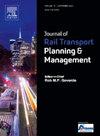Capacity evaluation of ERTMS/ETCS HTD and moving block
IF 2.7
Q3 TRANSPORTATION
Journal of Rail Transport Planning & Management
Pub Date : 2025-02-03
DOI:10.1016/j.jrtpm.2025.100506
引用次数: 0
Abstract
This paper compares the capacity effect of different implementations of ERTMS/ETCS (European Rail Traffic Management System/The European Train Control System): Hybrid Train Detection (HTD) and moving block. This is done both on a conceptual level by looking at a scenario involving two trains, and for a simulated network. The effects are studied by modelling HTD and moving block in the simulation tool RailSys, looking at the performance indicators related to capacity: headway, capacity utilisation, and punctuality. The model uses existing infrastructure and a complete timetable. The results of the scenario with two trains show that similar results on headway can be achieved with HTD compared to moving block This is true even with relatively long virtual blocks of 500 m. The results from the simulated network show that various shares of trains with train integrity, as well as moving block, have a minor effect on the performance indicator punctuality. Moving block gives some improvements on capacity utilisation compared to HTD. However, by implementing shorter virtual blocks at sections of lower speed, it is possible to achieve results on capacity utilisation like that engendered by moving block.
ERTMS/ETCS HTD和移动块的容量评估
本文比较了ERTMS/ETCS(欧洲轨道交通管理系统/欧洲列车控制系统)、混合列车检测(HTD)和移动阻塞的不同实施方式的容量效应。这是在概念层面上通过查看涉及两列火车的场景和模拟网络来完成的。通过在仿真工具RailSys中模拟HTD和移动块来研究其影响,并查看与容量相关的性能指标:车头时距、容量利用率和准点率。该模型使用现有的基础设施和完整的时间表。两列火车的场景结果表明,与移动街区相比,HTD可以获得相似的车头时距结果,即使是相对较长的500米虚拟街区也是如此。仿真结果表明,列车完整性的不同份额以及运行阻塞对性能指标正点率的影响较小。与HTD相比,移动块在容量利用率方面有一些改进。然而,通过在较低速度的部分实现较短的虚拟块,可以实现像移动块那样的容量利用结果。
本文章由计算机程序翻译,如有差异,请以英文原文为准。
求助全文
约1分钟内获得全文
求助全文
来源期刊

Journal of Rail Transport Planning & Management
TRANSPORTATION-
CiteScore
7.10
自引率
8.10%
发文量
41
 求助内容:
求助内容: 应助结果提醒方式:
应助结果提醒方式:


